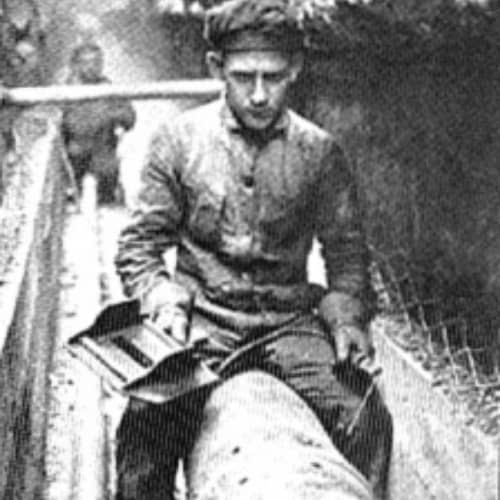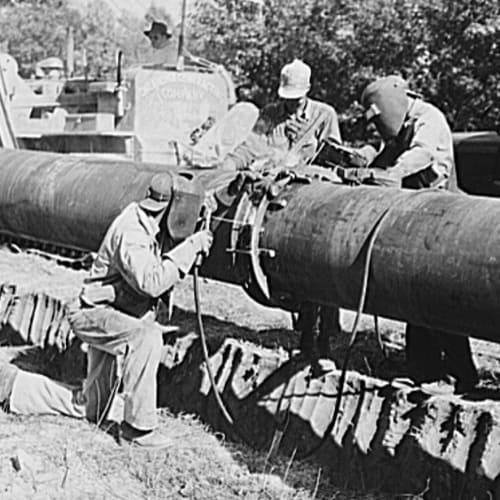Have you ever wondered who invented the welding machine? Can you imagine a world without welding? If our ancestors didn’t invest time and effort in this field, we wouldn’t have vehicles, bridges, or even the smallest kitchen utensils. But how did it all start? Who invented welding machines? What year was welding invented? How did it change over the years? If you’re curious, like we were, about these questions, then you came to the right place.
Who Invented Welding Machine? Arc welding was firstly inspired and invented by Sir Humphry Davy. In 1806, He made the first incandescent light bulb by producing an electric arc between two carbon electrodes. We’ll dive into the detailed history of welding from 4000 BC until today
Table of Contents
Who Invented Welding Machines and When?
It depends on the type of welding we’re referring to. Welding, as a concept, can be traced back to the chalcolithic age, aka the copper age. Humans back then used primitive forms of hammering and bending to join metals together.
In 1881, the French scientist, Auguste de Méritens was the first to use Davy’s concept into welding. He used carbon electrodes to create an arc at the workpiece. Although this didn’t generate enough heat to weld iron, it was sufficient to weld lead.
In the same year, Nikolai N. Benardos patented the use of an electrode holder to the work of Méritens. This idea made the process much easier and more applicable.
It wasn’t until 1888 that metal electrodes were used instead of carbon. This was initially introduced by Nikolay Slavyanov. He used this method to cast metal inside molds. Then, in 1898, Charles L. Coffin patented the idea of using metal electrodes in welding.
So, we can’t really credit the invention of the welding machine to one man. It was the collective effort of many genius scientists.

The History Of Welding: A Detailed Timeline
Alright, now that we’ve answered the main question, let’s start narrating the rest of the history.
B.C. Welding
As you might expect, welding wasn’t advanced during this period. However, it’s extremely interesting to learn how humans could harness what they had in this time to fabricate the amazing artifacts we see today.
Historians believe that welding started in Ancient Egypt in 4000 BC. They didn’t use any form of heat. Instead, they hammered and bent copper pieces together to produce bowls, tools, weapons, etc.
In 3000 BC, Egyptians started using charcoal as a heat source. This allowed them to transfer metal ore into some kind of sponge iron particles. Then, they used these particles to weld metals by hammering. We can say that this is the earliest known form of solid-state welding.
Around the same period, Sumerians were also working in the same field but through different methods. Historians believe that they were the first to apply hard soldering.
For instance, the tomb of Queen Puabi included a gold goblet with a brazed base. They were also the first to weld weapons like swords and daggers. The source of heat they used isn’t known, though.
Between 3000 and 2000 BC, bronze was extensively used in welding. Humans in this period crafted small bronze boxes by pressure welding of lap joints.
Mercury and iron smelting were discovered in 1500 BC. This paved the way for Egyptians to use soldering and blowpipes by 1330 BC. You can see clear welding marks on the mask of Tutankhamun.
By 1000 BC, ironwork was widely popular. In ancient Catalonia, furnaces were used to weld swords and superheads.
A.D. Welding
The presence of Roman scholars allowed for the first documentation of welding in this era. Pliny the Elder, one of the famous Roman authors, said that they used different kinds of salts as a flux in 60 AD. Moreover, they determined the brazing difficulty through the color of the metal.
Next, in 310 AD, Indians were able to forge-weld the Iron Pillar of Delhi. This was one of the most miraculous achievements of this time since the pillar weighs around 6 tonnes! Similar structures were crafted in other areas like Rome, England, and Scandinavia.
Welding in the Middle Ages (5th-15th Centuries)
Metalworking started to improve rapidly during the middle ages. This happened after blacksmithing gained attention as a valuable profession.
In the 5th century, forging and brazing were commonly used in Japan. A rare Japanese helmet was found combining iron and copper with welding and rivets.
Theophilus the Monk, one of the most famous authors throughout history, described the welding process they used during this period in one of his manuscripts. They used to braze silver with a flux crafted from potassium tartrate and sodium chloride.
Welding in the Age of Discovery (16th-18th Centuries)
During this period, the Italian Renaissance contributed a lot to metallurgy in general and welding in particular.
Vannoccio Biringuccio, a great Italian metallurgist, wrote an elaborate manual named “The Pirotechnia” in 1540. He described many of the welding methods used at this time. For instance, they used to place the bells in a forge or furnace prior to hammering.
He also mentioned how they welded fractures of metal tools like swords, saws, and sickles. After heating the workpieces, they placed low silver, crushed glass and borax in the fracture line. Then, they applied pressure with metal tongs until the pieces cooled slowly.
Benvenuto Cellini, a brilliant Italian sculptor, wrote about his brazing method in 1568. He used gold-copper-silver alloys to braze his stunning bronze statues.
Over to England, the first welded cast-iron cannon was made in 1543 by Ralf Hogge, a famous blacksmith at this time.
Discoveries of This Age
During this age, Europeans traveled a lot around the globe, searching for resources to establish trading routes. Such expeditions allowed for the discovery of new elements, metals, and ways that significantly improved welding.
Platinum was discovered in Colombia in 1735. It was used by the locals for welding in its pure form. This wasn’t strong enough, so Europeans used it in the form of platinum-gold alloys.
In 1751, nickel was discovered in german mines by the Swedish scientist Axel F. Cronstedt.
Henry Cavendish was the first to describe the properties of hydrogen gas in 1766. Later by 6 years, Oxygen was discovered by Carl W. Scheele. Furthermore, Antoine Lavoisier did the first successful experiment with combustion in 1772.
These three discoveries were the groundwork toward the emergence of gas welding.
Molybdenum, tungsten, zirconium, and titanium were discovered between 1780 and 1790 to mark the ending of this great age and the start of a greater one.
Welding in the 19th and 20th Century
We can easily agree that true welding started in this era. To keep things nice and clear, we’ll divide the discoveries of this era into two sections: arc welding and oxy-fuel welding.
Development of Arc Welding
Sir Humphry Davy provided the first inspiration for arc welding. In 1806, he succeeded in making the first incandescent light bulb by flowing electrical current between two carbon electrodes.
By 1881, Auguste de Méritens read about this concept and thought about implementing it in welding. However, it didn’t provide enough heat, so it was limited to welding lead.
Nikolai N. Benardos, one of Méritens students, successfully introduced the use of an electrode holder to his teacher’s work. This didn’t elevate the temperature, but it made the process a lot easier.
As a result, this carbon arc welding was extensively used in the manufacturing of lead-acid batteries, the battery type found in today’s cars.
Later in 1888, Nikolay Slavyanov was the first scientist to use the same concept but after replacing the carbon electrodes with consumable metal. Originally, he used this method to cast the metal rather than weld it.
Therefore, the first actual attempt of metal arc welding was patented by the American scientist Charles L. Coffin in 1898. But until then, the electrodes were exposed to the atmosphere, which resulted in a weak and porous weld.
Therefore, starting from 1900, scientists raced in developing shielded arc welding. A. Strohmenger was among the first by using lime and clay as flux. As you might know, such materials didn’t provide the required results.
Oscar Kjellberg came with a successful attempt in 1922. He dipped the metal electrodes inside a thick mixture of carbonates and silicates.

Development of Oxy-Fuel Welding
In one of his experiments in 1836, Edmund Davy accidentally discovered acetylene, one of the chemicals used in gas welding. Fun fact, Edmund Davy and Humphry Davy were cousins. It’s amazing to know that today’s welding was nearly founded by two men from the same family!
In 1900, a suitable torch for acetylene was successfully made, which allowed for its use in welding. Before that, gas welding was performed through hydrogen, coal gas, and oxygen.
Other Breakthroughs
Starting from 1885, Elihu Thompson started developing the basics of resistance welding. All its types were patented shortly after, including spot welding, projection welding, seam welding, and flash butt welding.
1919
During World War I, the world was in urgent need of welding for military and industrial purposes. Therefore, the American Welding Society was founded under the supervision of Comfort A. Adams, an American electrical engineer.
The alternating current was the other important discovery of this year. However, it wasn’t used in welding until the emergence of the heavy-coated electrodes in the 1930s.
The 1920s
Scientists faced a major challenge in welding highly reactive metals like aluminum and magnesium. Using flux-covered electrodes didn’t provide the necessary protection. Therefore, they started working on shielding the reaction with inert gas.
Irving Langmuir was the first to investigate this field. He used hydrogen as a shielding gas with tungsten electrodes in a process called atomic hydrogen welding. Later in this decade, argon and helium were also used as shielding gases.
These two breakthroughs were the forerunners of the gas tungsten arc welding (GTAW) and gas metal arc welding (GMAW).

The 1930s
The New York Navy Yard developed stud welding to attach the wood decking over the metal surfaces of ships. Later on, this welding method gained popularity in several construction industries.
The submerged arc welding was also invented in this period. In this method, the electric arc was covered by a powdered flux that simultaneously releases shielding gas.
Furthermore, hyperbaric welding was invented by Konstantin Khrenov which made welding possible in wet conditions and even underwater.
The 1940s
The gas tungsten arc welding was perfected in this decade thanks to Russell Meredith. He used non-consumable tungsten electrodes under the protection of helium, that’s why he called it HeliArc.
Afterward, the gas metal arc welding was invented. Similarly, it used helium as a shielding gas. But unlike GTAW, a consumable and continuously-fed wire was used as an electrode. This made the process much easier.
The 1950s
As we established, GMAW was already widely successful. However, the cost of helium prevented its application in multiple fields.
Luckily, scientists were able to replace helium with CO2, which made the process incredibly affordable. It also elevated the possible temperature inside the arc, which widened the use of this process even more.
Later on, the following advancements were introduced to arc welding:
Dualshield Welding:
Hollow electrodes had the flux material placed inside. So the atmosphere protection was provided by gas both inside and outside.
Innershield Welding
This is similar to the Dualshield, but without the use of external gas. That’s why it was notably affordable.

Electroslag Welding
A process that used standalone powder flux for shielding. It allowed welding of thicker metal parts.
In another context, cold welding was invented in this period. It was miraculous to know that two metals could fuse in a vacuum without any heat source. But it wasn’t used until humans went to space later in the 1960s.
The 1960s till Now
Since the 1960s, a lot has happened in the welding industry. To keep things simple, we’ll cover the most notable breakthroughs.
Firstly, the soviets developed friction welding around 1965. It combined the heat generated by rotating metal rods and the forging pressure that pushed them together.
Laser welding became popular in the 1980s. The concentrated heat of the laser beam allowed for welding in narrow and deep areas.

Today, welding has the highest quality and accuracy thanks to robotic welding. It also allowed us to weld in dangerous conditions without any safety risks.
Here, you can find an article from our website about the topic: Six Famous Female Welders
Final Thoughts
As the years go by, we can’t really know how welding will develop. The only thing we’re sure about, however, is that it’ll get more and more complicated.
After all, if you told a blacksmith in the middle ages that we’d be welding with a push of a button, he would’ve called you a heretic!
All that we can do now is wish to live until we see the impossible coming true.
Recommended Reading
Is Welding Easy to Learn? A Beginner’s Introduction

